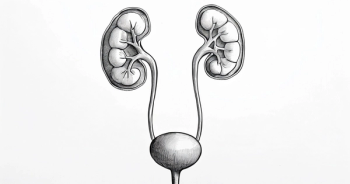
Lenvatinib Appears Effective in Real-Life Retrospective Analysis of Advanced HCC
The tyrosine kinase inhibitor lenvatinib demonstrated promising activity and safety in patients with advanced hepatocellular carcinoma in a retrospective multicenter observational analysis in Korea, according to a poster presentation at the 2020 Gastrointestinal Cancers Symposium.
The tyrosine kinase inhibitor lenvatinib (Lenvima) demonstrated promising activity and safety in patients with advanced hepatocellular carcinoma (HCC) in a retrospective multicenter observational analysis in Korea, according to a poster presentation at the 2020 Gastrointestinal (GI) Cancers Symposium.
The overall response rate (ORR) in the total population (n = 75), as assessed per RECIST version 1.1 was 10.7%. In the cohort of patients that received lenvatinib in the frontline setting (n = 50), the ORR was 14.0% versus 4.0% in those that received therapy in the second- to fourth-line settings (n = 25). The disease control rate (DCR) was 77.4% overall compared with 78.0% in the frontline and 76.0% in the later lines.
A complete response (CR) was not observed in any patients, but 8 patients in the overall population had a partial response (PR). Seven patients and 1 patient had a PR in the first- and later-line cohorts, respectively. Stable disease (SD) was observed in 50 patients overall (66.7%), including 32 patients in the frontline cohort (64.0%) and 18 patients in the later-line cohort (72.0%). Progressive disease (PD) was noted in 17 patients overall (22.7%) versus 11 patients treated in the frontline (22.0%) and 6 patients in later lines (24.0%).
In the overall patient population at a median follow-up of 4.7 months, the median overall survival (OS) was 6.7 months (95% CI, 5.2-8.1), and the median progression-free survival (PFS) was 4.6 months (95% CI, 3.6-5.6). In the frontline cohort, the median OS was 6.7 months (95% CI, 4.7-8.7), and the median PFS was 4.6 months (95% CI, 3.0-6.2) compared with 6.4 months (95% CI, 4.9-7.8) and 4.4 months (95% CI, 3.2-5.6) in the later line cohort, respectively.
Survival outcomes were also stratified by Child-Pugh class. In the patients with Child-Pugh A status (n = 57), the median OS was 7.1 months (95% CI, 5.7-8.5), and the median PFS was 4.6 months (95% CI, 3.5-5.7). In the 18 patients with Child-Pugh B status, the median OS was 5.3 months (95% CI, 2.0-8.5), and the median PFS was 2.6 months (95% CI, 0.6-4.6).
Investigators also analyzed the efficacy in patients who would have beenexcluded fromthe pivotal phase III REFLECT trial, such as those with tumor burdens occupying 50% or more of the liver, bile duct invasion, main portal vein invasion, and decreased liver function (Child-Pugh B and C). In these patients (n = 46), the ORR was 4.3% with RECIST 1.1 criteria. Two patients achieved a PR (4.3%), 33 had SD (71.7%), and 11 had PD (23.9%). The DCR was 76.0%.
In the cohort of patients who received prior immune checkpoint inhibitors (n = 13), 10 patients had SD (76.9%) and 3 had PD (23.1%). However, no patients had an objective response. The DCR was 76.9%.
Efficacy was also analyzed using modified RECIST criteria, which demonstrated similar results. The ORR in the total population was 12.0% versus 16.0% and 4.0% in those that received therapy in the first- and later-lines, respectively. In the group of patients who did not meet the inclusion criteria for REFLECT, the ORR was 8.7%.
Adverse events (AEs) of any grade were observed in 60 patients (80.0%), and the most common included aspartate aminotransferase (AST) elevation (61.3%), fatigue (37.3%), alanine aminotransferase elevation (29.3%), hyperbilirubinemia (29.3%), and thrombocytopenia (28.0%). Overall, 23 patients experienced grade 3/4 AEs (30.7%). Grade 3/4 events included hyperbilirubinemia (10.7%); AST elevation (8.0%); diarrhea (5.3%); hypertension (4.0%); thrombocytopenia (2.7%); and nausea, neutropenia, and proteinuria in 1 patient each (1.3%). Overall, 18 patients required a dose interruption or reduction due to AEs (24.0%).
To be included in the study, patients had to have a histologically or radiographically confirmed diagnosis of HCC, Child-Pugh class A or B, Barcelona clinic liver cancer (BCLC) B or C stage, and have at least 1 follow-up visit after initiation of lenvatinib therapy. Patients who were treated with lenvatinib between September 2018 and November 2019 from 3 Korean institutions were included in the analysis (n = 75).
Overall, 56 patients were male (74.7%) and 42 patients had an ECOG status of 0 or 1 (56.0%). Fifty-seven patients had Child-Pugh class A (76.0%) versus 18 patients with class B (24.0%). The majority of patients were BCLC stage C (66; 88.0%) compared with 9 patients in stage B (12.0%). The lenvatinib therapy was used in the frontline setting for 50 patients (66.7%), in the second-line setting for 14 patients (18.7%), and in the third-line or beyond in 11 patients (14.6%). Twenty-five patients had a prior systemic therapy (33.3%), and 23 patients had undergone surgery prior to treatment (30.7%).
Reference:
Cheon J, Yoo C, Bang J, et al. The efficacy and safety of lenvatinib (LEN) in Korean patients (pts) with advanced hepatocellular carcinoma (aHCC); multicenter retrospective analysis.J Clin Oncol. 2020;38(suppl 15;abstr 490).









































